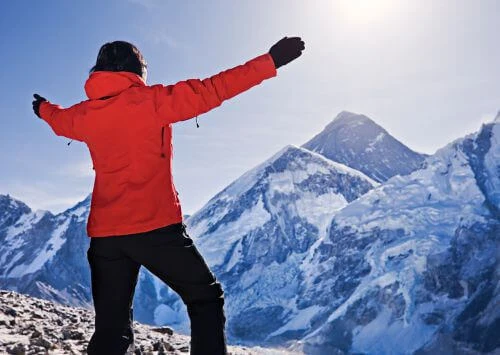People of the Himalayas.
The Himalayas is one wonder of nature that has intrigued us since time immemorial. Its high snow-clad mountains, rich flora and fauna, and scenic beauty have enchanted one and all. But in all this, we have somehow missed another wonderful aspect of it – its people. So, read on and find out more about the people living in the Himalayas, their history, faith, occupations and living conditions. Today, the Himalayan population can be classified into three ethnic types, namely Aryans, Mongoloids and Negroids. But the truth about its original inhabitants is still a point of debate. There is a belief that the first settlement in the Himalayas began in 1500 BC when a warrior tribe called Khasa migrated to its western range. This was followed by the migration of Tibeto-Burman people from Southeast Asia to the eastern and central Himalayas in the early part of the millennia. These people were called the Kiratas. However, if one takes into account the Hindu epics and Puranas, then it is deduced that the native inhabitants of the Himalayan region were the Kinnars, Kiratas, Kulinds and Kilinds, with later migration of the Darads and Khasas.
History tells us that the original inhabitants of the Himalayas were the Kinnars, Kilinds, and Kiratas. Our Hindu epics and Puranas give reference of their existence in the Himalayan regions. History also mentions the names of Khasas and the Darads. But today only three different ethnic groups form the Himalayan population. They are the Negroids, Mongoloids and the Aryans. The population, settlement in the Himalayan region is greatly influenced by the topography, economic pattern and the climatic condition. There is a complex blend of racial patterns in the people of Nepal. The dominant castes of Hindus, namely Chetri, Brahmin and Thakur, along with others, speak Nepali. The Tamangs, Limbus, Magars and Gurungs of Mongoloid strains dominate the middle hills and form the organized groups of tribal hill farmers. The Sherpas from the Solo Khumbu region of the northeast are among the many groups of Bhutiyas that speak in Tibetan dialects.
The climate condition is one of the main factors for the population settlements since extreme climatic condition imposes a restriction on the living conditions and tends to restrict movement and communication. But the ethnic groups living in remote valleys of the Himalayan region have generally conserved their traditional cultural identities. But improvements in communication and transportation system have improved the lifestyle of the people living in those regions. The modernization is affecting the traditional cultural and social system of the areas. The population in the Himalayan region is nearly about 40 million. The Hindus of the Indian origin mainly dominate the Sub Himalayan and the Middle Himalayan valleys. In central Nepal, both Indian and Tibetan cultures have blend together, producing a mixed culture of Indian and Tibetan traits.
Another aspect that holds true for all those dwelling in the Himalayas and its foothills is that they worship mountain as their life-giver, preserver and protector. All the communities living in the Himalayan region are nature-dependent, and strongly ethnic and religious. However, this may not be exactly true for those residing in the arid wilderness of the dense forests of the eastern slopes and northern flanks; here people are quite fierce and warrior-like. However, in general sense, the people dwelling in the Himalayas are basically peace-loving. And this can be totally experienced when exploring the various Himalayan destinations. Their warm hospitality makes one realize that they are totally respectful towards the environment they live in, and that their harsh living conditions do not hamper their spirits or way of enjoying life.
Tribes and Ethnic Groups of Himalayas People
A diverse group of people inhabits the Himalayas, characterized by their unique traditions, lifestyles, and languages. Some of the well-known ethnic groups in the Himalayas include the Sherpa, Tamang, Gurungs, Limbus, and others. These are known to be the local inhabitants of the Himalayan region of Nepal and have been living in the area since ancient times. With their unique tradition, lifestyles, and languages, these people thrive in icy conditions while adapting to the Mountain. Some of the most popular tribes and ethnic groups of the mountains are briefly described below:
Sherpas: The Heroes of Mountain
The Sherpa people are the most renowned groups of the Himalayan people. Known for their exceptional strength and experience in mountain climbing and trekking, the Sherpa people possess outstanding mountaineering skills. The Sherpas are the backbone for mountain climbers as they assist locals or foreigners towards the top of the Mountain, including Everest or other high peaks. The Sherpas are believed to have originated from Tibet and have lived in the Himalayas of Nepal for over a century. They are well-adapted to endure the high-altitude environment, as the body is naturally adapted to thin air. Similarly, the Sherpa people possess abundant stamina unmatched by those from the lower regions. In the Nepalese tourism industry, Sherpa people act as mountain guides, trekking guides, porters, cooks, or other adventure staff, making it their primary occupation, which earns them a living through climbers and trekkers who wish to visit Nepal. On the other hand, the sherpa people mainly follow Tibetan Buddhism, with Mani Rimdu being the grandest festival. They also celebrate different festivals, such as Lhosar (Tibetan New Year) and Dumje.
Tamang: The Keepers of the Hillsong
Tamangs are another beautiful ethnic group of the Himalayas of Nepal. These people are known for their rich musical traditions and for keeping a deep connection with nature. However, the Tamang people are not only particular to the Himalayan region but are also found in the hilly regions and central areas. The Tamang people are also known for their agricultural lifestyle, in which animal husbandry was once the primary occupation. However, with the improvement of education and modernization, the Tamang people are diversifying into various industries and professions. Likewise, the Tamang people reside in the terraced villages of the mountains, where they cultivate crops such as barley, rice, and millet. Besides, spiritually, the Tamang people follow Tibetan Buddhism and possess a rich cultural heritage. In the tourism industry, the Tamangs also serve as mountain guides, trekking guides, and porters. The main festival of Tamangs is Sonam Lhosar.
Gurung: The Warriors of the Himalayas
Gurungs are another ethnic group of the Himalayas that are widely spread throughout the hilly and central regions of Nepal. The Gurung people are known for their warrior nature and are highly respected for their bravery. Historically, the Gurung people served as mercenaries in the Khasa armies under the Shah dynasty and are believed to have played a crucial role in Prithivi Narayan Shah's unification campaign. Now, Gurung people are mainly in the army, serving under the Gurkha Regiment. Besides bravery, the Gurung people are known for their hospitality, adhering to both Buddhist and Hindu religions and cultures. Likewise, the major festival of the Gurung people is Tamu Losar, but they also observe various other celebrations.
Limbu: The Keepers of Kirat Wisdom
The Limbus are another vibrant ethnic group of the Himalayas who are indigenous to the Himalayan Limbuwan region, including Nepal, Sikkim, and Bhutan. These people have ancient Kirat Mundhum traditions, thereby maintaining a strong connection with the Kirat culture, tradition, and wisdom. The Limbu people follow Buddhism but still practice some aspects of Hinduism. A typical Limbu family has a complex social structure with various roles and responsibilities and is known for its influence on women within the family.





